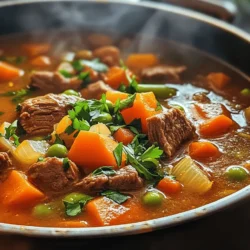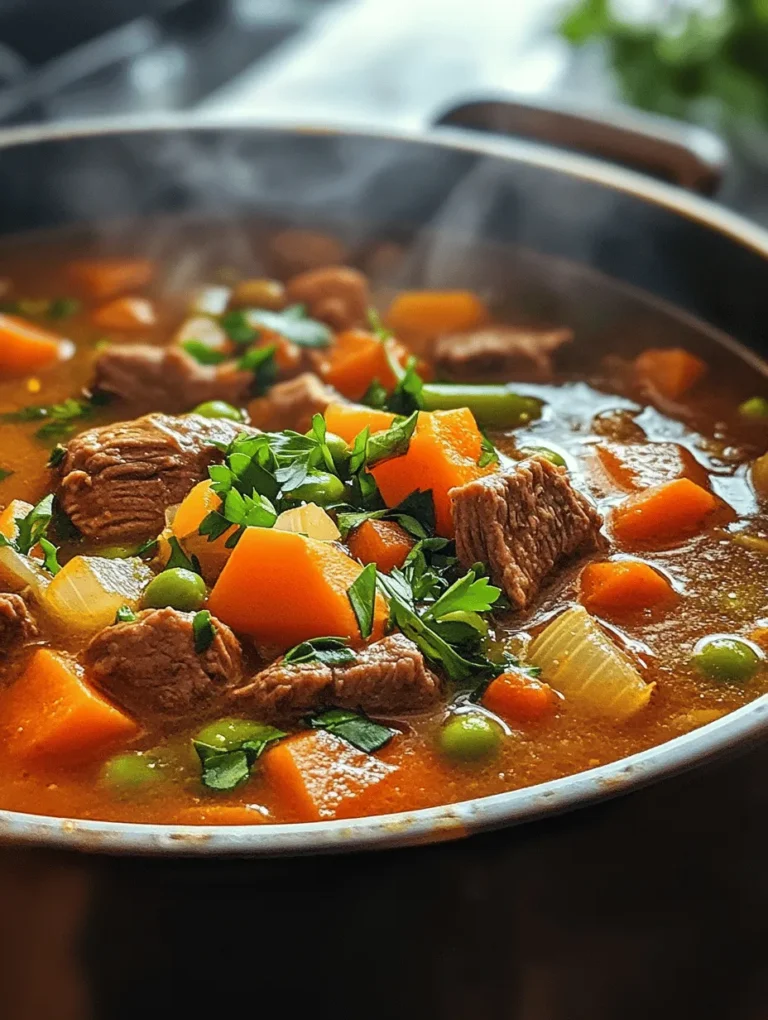Introduction
As the temperatures drop and the days grow shorter, there’s nothing quite like a warm bowl of soup to bring comfort and nourishment. Hearty vegetable beef soup is the quintessential dish that evokes feelings of warmth and coziness, making it the perfect meal for chilly evenings. The combination of tender beef, vibrant vegetables, and aromatic herbs creates a satisfying and nutritious dish that not only fills the belly but also warms the spirit.
This recipe for hearty vegetable beef soup showcases wholesome ingredients that come together to create a comforting meal ideal for family gatherings or a quiet night in. Each spoonful is rich in flavor and nutrients, making it a go-to option for those seeking both comfort and health. Picture yourself nestled under a blanket, savoring a steaming bowl of this homemade soup, as the world outside grows colder. It’s the ultimate cozy night experience.
Understanding the Ingredients
To create a truly memorable and delicious vegetable beef soup, it’s essential to understand the key ingredients that contribute to its flavor and nutritional profile. Each component plays a crucial role, ensuring that the soup is not just hearty but also a wholesome delight.
Beef Stew Meat
The foundation of any great beef soup starts with the meat itself. For this recipe, beef stew meat is the best choice. Typically cut from tougher cuts of beef, such as chuck or round, stew meat becomes tender and flavorful when cooked slowly. Here’s why these cuts are ideal for soup:
– Chuck Roast: This is a popular choice for beef stew due to its rich marbling. It breaks down beautifully during long cooking times, resulting in tender pieces that melt in your mouth.
– Round Roast: A leaner option compared to chuck, round cuts are still suitable for soup but may require slightly more attention to prevent them from becoming dry.
When selecting beef for your soup, look for well-marbled pieces, as the fat contributes flavor and moisture, enhancing the overall taste of the dish. Additionally, it’s always best to purchase your meat from a trusted butcher or local market to ensure quality.
Vegetables
Vegetables are the stars of this soup, adding not only flavor but also a myriad of nutrients. Fresh, seasonal vegetables are paramount to a successful and vibrant soup. Here are some of the key vegetables you should consider including:
– Carrots: Sweet and colorful, carrots add a natural sweetness to the soup while providing essential vitamins like A and K.
– Celery: Known for its crisp texture and subtle flavor, celery contributes to the soup’s aromatic base and offers hydration due to its high water content.
– Potatoes: These starchy gems add heartiness to the soup, making it more filling. They also absorb the flavors of the broth beautifully.
– Onions and Garlic: Essential for building flavor, onions and garlic provide depth and aroma, enhancing the overall profile of the soup.
When selecting your vegetables, opt for the freshest options available. Farmers’ markets or local grocery stores often have seasonal produce that can really elevate the taste of your soup.
Herbs and Spices
Herbs and spices are what elevate a simple vegetable beef soup into a flavor-packed dish. The right combination of herbs can transform the broth into a fragrant and savory experience. Key herbs for this recipe include:
– Thyme: Earthy and slightly minty, thyme pairs exceptionally well with beef, providing a warm undertone to the soup.
– Oregano: With its slightly peppery flavor, oregano adds depth and a hint of Mediterranean flair to the dish.
– Bay Leaves: Often used in soups and stews, bay leaves impart a subtle flavor that complements the richness of the beef and the freshness of the vegetables.
When using dried herbs, remember that their flavors are more concentrated than fresh. If using fresh herbs, you may want to increase the quantity to achieve a similar flavor profile.
Broth
The broth is the heart of the soup and can make or break your dish. A great broth serves as the foundation, pulling all the flavors together. You have a couple of options when it comes to choosing the broth for your hearty vegetable beef soup:
– Homemade Beef Broth: If you have time, making your own broth from roasted bones will yield a richer, more flavorful base. This allows you to control the ingredients and ensure a wholesome soup.
– Store-Bought Broth: If you’re short on time, high-quality store-bought beef broth can work perfectly. Look for low-sodium options to better control the salt levels in your soup.
Regardless of your choice, ensure that the broth complements the other ingredients. A well-seasoned broth enhances the overall flavor of the soup, making each spoonful delightful.
The Cooking Process
Now that you have a solid understanding of the ingredients, it’s time to dive into the cooking process. The method used to prepare the hearty vegetable beef soup is just as important as the ingredients themselves. Here’s a step-by-step breakdown of how to create this delicious dish.
Step 1: Browning the Beef
The first step in making your hearty vegetable beef soup is to brown the beef stew meat. This critical step is not just about cooking the meat; it’s about developing flavor through the Maillard reaction, which occurs when proteins are exposed to high heat.
– Heat your pot: Start by heating a large pot or Dutch oven over medium-high heat. Add a splash of oil, such as olive or vegetable oil, to the pot.
– Brown the meat: Once the oil is shimmering, add the beef in batches to avoid overcrowding. Allow it to sear without moving it for a few minutes until it forms a rich brown crust. This step not only adds depth of flavor but also gives the soup a beautiful color.
After browning, remove the beef from the pot and set it aside. This process enhances the overall taste of the soup, ensuring that the beef contributes a robust flavor profile.
Step 2: Sautéing the Vegetables
Once you have browned the beef, it’s time to sauté your vegetables. This step is crucial for enhancing the sweetness and depth of flavors in the soup.
– Sauté the aromatics: In the same pot, add your chopped onions and garlic. Cook them for 2-3 minutes until the onions become translucent and fragrant. This will create a flavorful base for your soup.
– Add remaining vegetables: Next, add the carrots, celery, and any other vegetables you desire. Sauté them for an additional 5-7 minutes, stirring occasionally, until they begin to soften. This technique allows the natural sugars in the vegetables to caramelize, intensifying their flavors.
Step 3: Combining Ingredients
After the vegetables are sautéed, it’s time to bring everything together.
– Return the beef: Add the browned beef back into the pot, along with any juices that have accumulated. This will infuse the soup with even more flavor.
– Add the broth: Pour in your beef broth, ensuring that the meat and vegetables are fully submerged. If you’re using homemade broth, this is where its rich flavor will shine through.
Step 4: Simmering
The final step in the cooking process involves simmering the soup to allow the flavors to meld together beautifully.
– Bring to a boil: Increase the heat to high and bring the soup to a gentle boil.
– Reduce heat and simmer: Once boiling, reduce the heat to low and cover the pot. Allow the soup to simmer for at least 1.5 to 2 hours. This slow cooking process will tenderize the meat and allow the flavors to meld, resulting in a rich and hearty soup.
During this simmering time, you can use this opportunity to relax, knowing that your cozy night is just around the corner. The comforting aroma will fill your kitchen, making it hard to resist sneaking a taste along the way.
As you embark on this culinary journey, remember that the heart of the hearty vegetable beef soup lies not just in its ingredients but also in the love and care you put into preparing it. With the right approach, you’ll end up with a delicious, wholesome dish that is sure to become a family favorite for many cozy nights to come.
Overview of the Health Benefits of the Soup Ingredients
Hearty Vegetable Beef Soup is not just a delicious meal; it’s a powerhouse of nutrition that packs a punch with its wholesome ingredients. Each component brings unique health benefits, making this dish a fantastic choice for anyone looking to eat healthily without sacrificing flavor.
Protein from Beef: Essential Nutrients for Muscle Repair and Energy
The beef in this soup is a significant source of high-quality protein, which is vital for muscle repair, energy production, and overall bodily functions. Protein helps build and repair tissues, making it essential for maintaining muscle mass, especially for those engaged in regular physical activity. Additionally, beef is rich in important nutrients such as iron, zinc, and B vitamins, which play crucial roles in oxygen transport, immune function, and energy metabolism. While using lean cuts of beef can reduce calorie intake, it still delivers the satisfying taste and texture that beef lovers crave.
Vegetables: Vitamins and Minerals that Contribute to Overall Health
The assortment of vegetables in this soup, such as carrots, potatoes, celery, and green beans, contributes a variety of vitamins and minerals essential for good health. Carrots are high in beta-carotene, which promotes eye health and supports the immune system. Potatoes provide potassium, which helps regulate blood pressure, while celery is low in calories and high in fiber, aiding digestion. Green beans add vitamin C and K, vital for skin health and bone strength. Together, these vegetables not only enhance the flavor of the soup but also offer a rich supply of antioxidants that fight inflammation and promote overall wellness.
Low-Calorie Options: How to Make the Soup Lighter Without Sacrificing Taste
For those looking to reduce caloric intake, there are easy modifications to make Hearty Vegetable Beef Soup lighter while keeping its rich flavor. Opting for leaner cuts of beef, such as sirloin or round steak, can significantly cut down on fat content. Additionally, using low-sodium beef broth or making your own broth from scratch can help control sodium levels. Increasing the proportion of vegetables relative to meat not only lowers calories but also boosts fiber intake, making the soup more filling. Lastly, substituting starchy vegetables like potatoes with lower-calorie options such as zucchini or cauliflower can further lighten the dish without compromising taste.
Variations and Customizations
One of the joys of cooking is the ability to customize recipes to suit individual tastes and dietary needs. Hearty Vegetable Beef Soup is versatile, allowing for numerous variations that can cater to different preferences.
Suggestions for Ingredient Substitutions Based on Dietary Preferences
If you’re looking to adjust the recipe to accommodate dietary restrictions or preferences, there are plenty of substitutions you can consider. For instance, if you prefer a milder flavor, consider using chicken or turkey instead of beef. You can also replace beef broth with vegetable broth for a lighter base. If you want to add a different texture, consider incorporating lentils or beans for added protein and fiber while keeping the dish hearty.
Vegetarian or Vegan Alternatives: Options for Plant-Based Proteins
For those following a vegetarian or vegan diet, the Hearty Vegetable Beef Soup can easily be adapted. Replace the beef with plant-based proteins like tempeh, tofu, or chickpeas, which provide a good source of protein while maintaining the soup’s hearty quality. Use vegetable broth as the base and enhance the flavor with umami-rich ingredients like mushrooms or soy sauce. You can also add more legumes or grains, such as quinoa or barley, to create a filling, protein-rich soup.
Seasonal Adjustments: How to Incorporate Seasonal Vegetables for Freshness
One of the best ways to keep the soup vibrant and fresh is by incorporating seasonal vegetables. In the spring, you might add asparagus or peas, while summer can bring in zucchini or fresh corn. Autumn is perfect for adding squash or sweet potatoes, and winter vegetables like parsnips or kale can bring robust flavors to the dish. Utilizing seasonal produce not only enhances the freshness of your soup but also ensures you’re consuming ingredients at their peak flavor and nutritional value.
Flavor Enhancements: Adding Different Herbs or Spices for Personalized Taste
To make your Hearty Vegetable Beef Soup truly your own, consider experimenting with various herbs and spices. Fresh herbs like thyme, rosemary, or parsley can elevate the flavor profile. If you enjoy a bit of heat, adding red pepper flakes or a dash of hot sauce can provide a delightful kick. For a more international flair, consider adding spices like cumin or coriander, which can introduce interesting layers of flavor. Taste as you go, and adjust the seasonings until you find the perfect balance that suits your palate.
Serving Suggestions
Serving Hearty Vegetable Beef Soup can be as enjoyable as making it. Here are some ideas to elevate your dining experience.
Ideal Pairings with the Soup
This soup is delicious on its own but can be complemented beautifully with various sides. Freshly baked bread, such as a crusty baguette or soft dinner rolls, is perfect for dipping into the hearty broth. A crisp garden salad with a tangy vinaigrette can provide a refreshing contrast to the warm soup. Alternatively, consider pairing it with a side of roasted vegetables for a wholesome meal that’s both comforting and filling.
Presentation Tips: Creative Ways to Serve and Garnish the Soup for Visual Appeal
Presentation is key to an enjoyable dining experience. Serve the soup in rustic bowls to enhance its homey feel. For an elegant touch, consider garnishing each bowl with fresh herbs like parsley or cilantro, adding a pop of color and freshness. A sprinkle of grated Parmesan cheese or a dollop of sour cream can also add richness and flavor. If you’re feeling creative, try serving the soup in hollowed-out bread bowls for a unique and edible serving option.
Storing and Reheating
If you find yourself with leftovers, storing and reheating your Hearty Vegetable Beef Soup properly will ensure it remains delicious and safe to eat.
Best Practices for Storing Leftover Soup
When storing leftover soup, allow it to cool to room temperature before transferring it to airtight containers. Glass containers are ideal as they are non-reactive and can be reheated directly. Divide the soup into single-serving portions to make reheating quicker and easier. Store it in the refrigerator if you plan to consume it within a few days, or freeze it for longer storage—up to three months. Be sure to label the containers with the date for easy tracking.
Reheating Methods: Ensuring the Soup Retains Its Quality and Flavors
When reheating your soup, the goal is to preserve its flavor and texture. The microwave is a quick option, but for best results, reheat the soup on the stovetop over medium heat, stirring occasionally to ensure even heating. If the soup appears too thick after freezing, add a splash of broth or water to reach your desired consistency. Always taste before serving, as flavors may deepen during storage, and you may need to adjust the seasoning.
Conclusion
Hearty Vegetable Beef Soup is more than just a meal; it’s a comforting embrace on a chilly night. Each bowl is filled with nourishing ingredients that not only warm the body but also provide essential nutrients for overall health. The process of making this soup can become a cherished family tradition, bringing loved ones together to enjoy the warmth and flavors it offers.
Whether you’re enjoying it on a cozy night in or serving it to friends and family, this soup is sure to create lasting memories. Embrace the opportunity to explore this recipe, make it your own, and share it with those you hold dear. As you gather around the table, you’ll not only savor the delightful taste of Hearty Vegetable Beef Soup but also the joy of sharing a heartfelt meal that brings everyone closer together.



